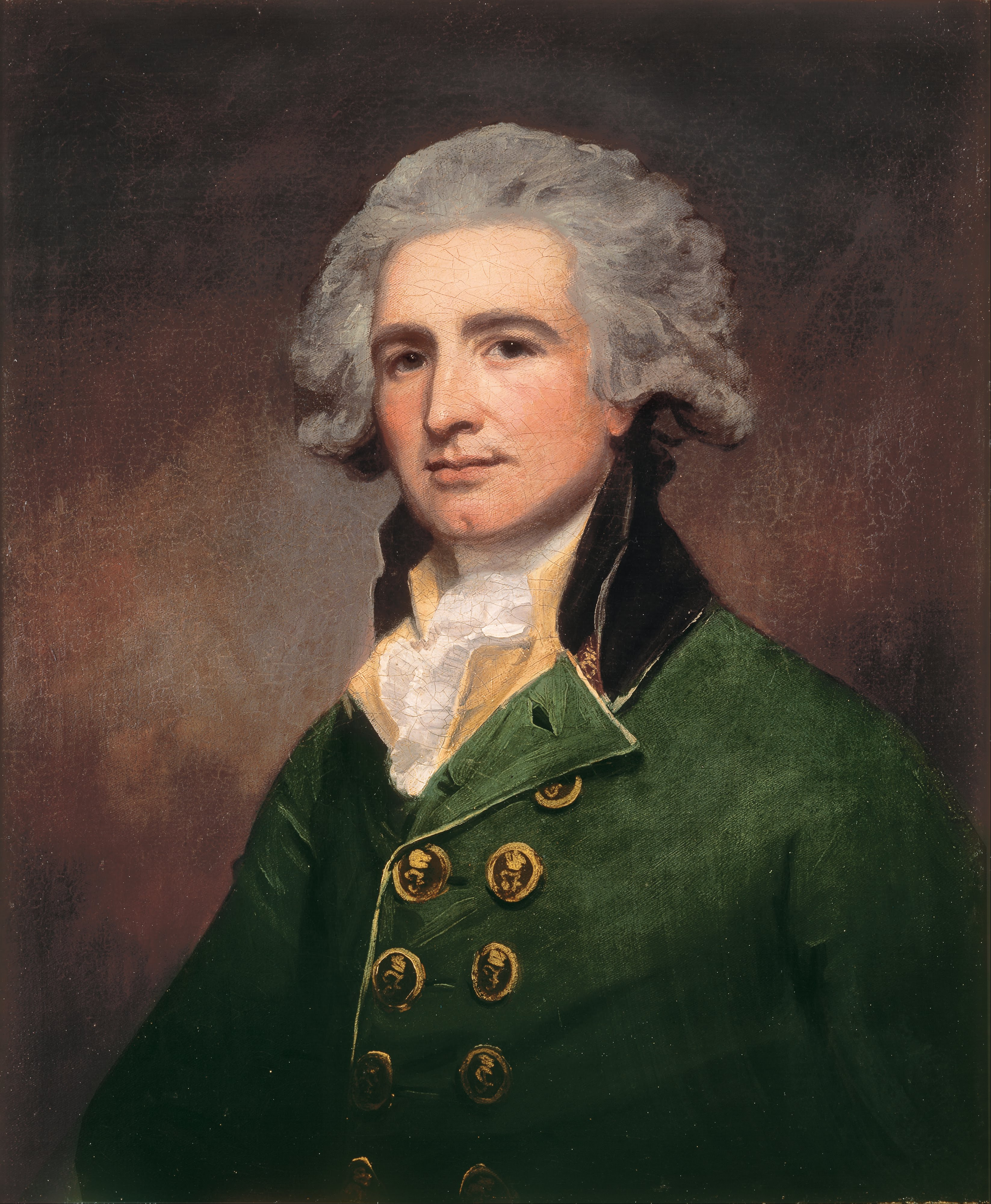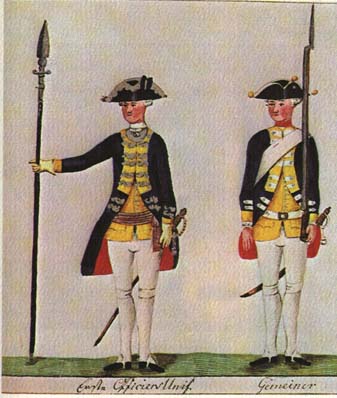|
Brandywine Order Of Battle
At the Battle of Brandywine on September 11, 1777 a colonial American army led by General George Washington fought a British-Hessian army commanded by General William Howe, 5th Viscount Howe. Washington drew up his troops in a defensive position behind Brandywine Creek. Howe sent Lieutenant General Wilhelm von Knyphausen's 5,000 troops to demonstrate against the American front at Chadd's Ford. Meanwhile, Lieutenant General Charles Cornwallis took 10,000 troops on a wide flank march that crossed the creek and got in the rear of the American right wing under Major General John Sullivan. The Americans changed front but Howe's attack broke through.Eggenberger, p. 59 As Howe's wing made progress, Knyphausen converted his feint into a frontal attack on the American center. Washington's army was driven to the rear in disarray, but was saved from rout by Major General Nathanael Greene's rear guard action. Washington's army retreated to Chester, Pennsylvania while Howe occupied Wilmington ... [...More Info...] [...Related Items...] OR: [Wikipedia] [Google] [Baidu] |
Lord Cornwallis
Charles Cornwallis, 1st Marquess Cornwallis, (31 December 1738 – 5 October 1805), styled Viscount Brome between 1753 and 1762 and known as the Earl Cornwallis between 1762 and 1792, was a British Army general and official. In the United States and the United Kingdom, he is best remembered as one of the leading British generals in the American War of Independence. His surrender in 1781 to a combined American and French force at the siege of Yorktown ended significant hostilities in North America. He later served as a civil and military governor in Ireland, where he helped bring about the Act of Union; and in India, where he helped enact the Cornwallis Code and the Permanent Settlement. Born into an aristocratic family and educated at Eton and Cambridge, Cornwallis joined the army in 1757, seeing action in the Seven Years' War. Upon his father's death in 1762 he became Earl Cornwallis and entered the House of Lords. From 1766 until 1805 he was Colonel of the 33rd Regiment ... [...More Info...] [...Related Items...] OR: [Wikipedia] [Google] [Baidu] |
Henry Monckton (British Army Officer)
Henry Monckton (13 July 1740 – 28 June 1778) was the fourth son of John Monckton, 1st Viscount Galway, and the younger half-brother of the more famous Robert Monckton. During the American Revolutionary War he led a battalion of converged British grenadiers while a lieutenant colonel. He was wounded at Long Island during the New York and New Jersey campaign in 1776. He led a temporary brigade at Assunpink Creek. In the Philadelphia campaign of 1777, he led a grenadier battalion at both the Battle of Brandywine and the Battle of Germantown. He was killed leading his soldiers at the Battle of Monmouth on 28 June 1778. Early career Born on 13 July 1740, Monckton was the fourth son of John Monckton, 1st Viscount Galway, although the second by his second wife, Jane Westenra of Rathleagh, Queen's County, Ireland.Dodge, ''Monckton'' His older half-brother Robert Monckton (1726–1782) became a high ranking general officer in the British army, as later did his nephew, Henry, t ... [...More Info...] [...Related Items...] OR: [Wikipedia] [Google] [Baidu] |
William Medows
General Sir William Medows KB (31 December 1738 – 14 November 1813) was an Englishman and a general in the British Army. He entered the army in 1756 and saw action in North America, the Cape, and India. In 1788 he was appointed Governor of Bombay, transferring to become Governor of Madras in 1790. That year, at the head of 15,000 men, he attacked Tipu Sultan of Mysore. In a see-saw campaign he was slightly wounded, mishandled a crucial assault and attempted suicide before the war ended in Britain's favour. In 1801 he was appointed Commander-in-Chief, Ireland as a full general. Military career Sir William was the son of Philip Medows, deputy ranger of Richmond Park, and Lady Frances Pierrepont, granddaughter of the Duke of Kingston-upon-Hull (1655–1756). He entered the British Army as an ensign in the 50th Regiment of Foot in 1756. In 1760 he went with his regiment to join the allied army under Prince Ferdinand of Brunswick, who as Frederick the Great's lieutenant was defe ... [...More Info...] [...Related Items...] OR: [Wikipedia] [Google] [Baidu] |
John Maitland (British Army Officer)
Lieutenant-Colonel John Maitland (1732 – 25 October 1779) was a British Marine and Army officer and politician who sat in the House of Commons between 1774 and 1779. Maitland was the eighth surviving son of Charles Maitland, 6th Earl of Lauderdale, and his wife Lady Elizabeth Ogilvy, daughter of James Ogilvy, 4th Earl of Findlater. He was a Captain in the Royal Marines in 1757 and served in the Seven Years' War, losing his right arm in action.Scott Martin, Bernard F. Harris Jr ‘'Savannah 1779: The British turn south'’ Bloomsbury Publishing, 24 August 2017 page 15 When peace came in 1763 he went onto half-pay. In 1768 Maitland stood for Parliament at Haddington Burghs when there was a double return, but decided not to contest the matter. He was appointed Clerk of the Pipe in Scottish Exchequer in 1769. He returned to the active list in 1770 and became a major in 1775. Meanwhile, he was returned at the 1774 general election as Member of Parliament for Haddington Burghs. Lit ... [...More Info...] [...Related Items...] OR: [Wikipedia] [Google] [Baidu] |
Robert Abercromby Of Airthrey
General Sir Robert Abercromby (21 October 17403 November 1827), the youngest brother of Sir Ralph Abercromby, was a general in the army, Governor of Bombay and Commander-in-Chief of the Bombay Army and then Commander-in-Chief, India, the East India Company. He was the son of Prof George Abercromby (1705-1800) of Tullibody House. Military career Abercromby served in the French and Indian War, and was promoted captain in 1761. On 30 Nov. 1775, he was promoted to lieutenant colonel of the 37th Regiment of Foot. During the American Revolutionary War, he fought at the Battle of Long Island, the Battle of Brandywine, the Battle of Germantown, the Battle of Crooked Billet, the Battle of Monmouth and at the sieges of Charleston and Yorktown, where he commanded the left wing of the British forces. He commanded a battalion of light infantry for most of the war. After the war, he was made Colonel for life of the 75th (Highland) Regiment, a regiment newly raised to deter the French ... [...More Info...] [...Related Items...] OR: [Wikipedia] [Google] [Baidu] |
George Romney - Colonel Robert Abercrombie - Google Art Project
George may refer to: People * George (given name) * George (surname) * George (singer), American-Canadian singer George Nozuka, known by the mononym George * George Washington, First President of the United States * George W. Bush, 43rd President of the United States * George H. W. Bush, 41st President of the United States * George V, King of Great Britain, Ireland, the British Dominions and Emperor of India from 1910-1936 * George VI, King of Great Britain, Ireland, the British Dominions and Emperor of India from 1936-1952 * Prince George of Wales * George Papagheorghe also known as Jorge / GEØRGE * George, stage name of Giorgio Moroder * George Harrison, an English musician and singer-songwriter Places South Africa * George, Western Cape ** George Airport United States * George, Iowa * George, Missouri * George, Washington * George County, Mississippi * George Air Force Base, a former U.S. Air Force base located in California Characters * George (Peppa Pig), a 2-year-old pig ... [...More Info...] [...Related Items...] OR: [Wikipedia] [Google] [Baidu] |
Charles O'Hara
General Charles O'Hara (1740 – 25 February 1802) was a British Army officer who served in the Seven Years' War, the American War of Independence, and the French Revolutionary War and later served as governor of Gibraltar. He served with distinction during the American War of Independence, commanding a brigade of Foot Guards as part of the army of Charles Cornwallis and was wounded during the Battle of Guilford Courthouse. He offered the British surrender during the Siege of Yorktown on behalf of his superior Charles Cornwallis and is depicted in the eponymous painting by John Trumbull. During his career O'Hara personally surrendered to both George Washington and Napoleon Bonaparte. O'Hara's Battery and O'Hara's Tower in Gibraltar were named after him. Early life Charles O'Hara was born in Lisbon, Portugal, the illegitimate son of James O'Hara, 2nd Baron Tyrawley and Kilmaine (and eventually promoted Field Marshal in 1763); and his Portuguese mistress. Charles was sent ... [...More Info...] [...Related Items...] OR: [Wikipedia] [Google] [Baidu] |
Sir John Wrottesley, 8th Baronet
Sir John Wrottesley, 8th Baronet (22 December 1744 – 23 April 1787), of Wrottesley Hall in Staffordshire, was a British army officer and politician who was a Member of the British House of Commons from 1768 to 1787. Background and early life Wrottesley was the eldest son of the Reverend Sir Richard Wrottesley, 7th Baronet, Dean of Worcester, and Mary, the daughter of John Leveson-Gower, 1st Earl Gower. This grandfather was head of the most powerful Whig political dynasty in Staffordshire, based at Trentham Hall: the Leveson-Gowers controlled a number of seats in the unreformed House of Commons. In 1754, Gower died and was succeeded by Wrottesley's uncle, Granville Leveson-Gower. Wrottesley determined on an army career, being commissioned as ensign of the 2nd Foot Guards during 1761 and transferring as captain of the 85th Foot the next year. From 1766 to 1767, he was equerry to the Duke of York. Wrottesley's political associations were strengthened when his uncle, Gower, ... [...More Info...] [...Related Items...] OR: [Wikipedia] [Google] [Baidu] |
Sir George Osborn, 4th Baronet
Sir George Osborn, 4th Baronet (10 May 1742 – 29 June 1818) was born into the British aristocracy. He fought in the American Revolutionary War as a British officer. He served in the House of Commons from 1769 to 1784 - before, during, and after that conflict. In 1777 he led a detachment of the Guards Brigade at the battles of Brandywine and Germantown. Besides his combat duties, he served as the inspector of the Hessian mercenary soldiers. After returning from America in 1777 he was promoted in rank to general officer. In 1787 he received advancement to lieutenant general. He is remembered in United States history for a clever but harsh comment that he made concerning the dead body of an American officer. Early career Born on 10 May 1742,Rayment, ''Penryn (Cornwall)'' Osborn was the oldest son of Sir Danvers Osborn, 3rd Baronet and educated at Westminster School and Trinity College, Cambridge. He succeeded to the baronetcy and the family seat at Chicksands Priory when his fathe ... [...More Info...] [...Related Items...] OR: [Wikipedia] [Google] [Baidu] |
Scots Guards
The Scots Guards (SG) is one of the five Foot Guards regiments of the British Army. Its origins are as the personal bodyguard of King Charles I of England and Scotland. Its lineage can be traced back to 1642, although it was only placed on the English Establishment (thus becoming part of what is now the British Army) in 1686. History Formation; 17th century The regiment now known as the Scots Guards traces its origins to the Marquis of Argyll's Royal Regiment, a unit raised in 1642 by Archibald Campbell, 1st Marquess of Argyll in response to the 1641 Irish Rebellion. After the Restoration of Charles II, the Earl of Linlithgow received a commission dated 23 November 1660 to raise a regiment which was called The Scottish Regiment of Footguards. It served in the 1679 Covenanter rising of 1679, as well as Argyll's Rising in June 1685, after which it was expanded to two battalions. When the Nine Years War began in 1689, the first battalion was sent to Flanders; the second served ... [...More Info...] [...Related Items...] OR: [Wikipedia] [Google] [Baidu] |




.jpg)

